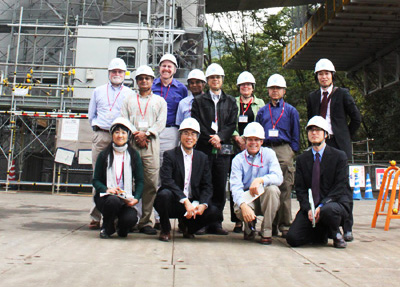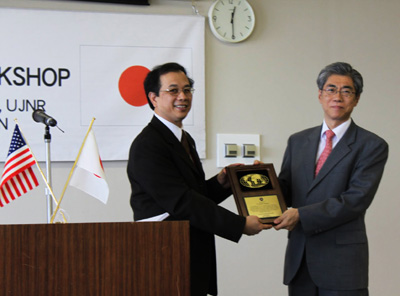U.S. Department of Transportation
Federal Highway Administration
1200 New Jersey Avenue, SE
Washington, DC 20590
202-366-4000
Focus
| Accelerating Infrastructure Innovations |
Publication Number: FHWA-HRT-10-008
Date: November 2009
The Federal Highway Administration (FHWA) and the Public Works Research Institute (PWRI) of Japan celebrated the 25th anniversary of the U.S.-Japan Bridge Engineering Workshop in Tsukuba, Japan, in October 2009. Held under the auspices of the U.S.-Japan Cooperative Program in Natural Resources, which was established in 1964 to share research results and sponsor staff exchanges, the workshop brings together bridge engineers and researchers annually for discussions on such topics as earthquake protection, reduction of wind damage, bridge management, and high-performance materials.
More than 55 participants attended the 2009 workshop, including 13 U.S. delegates representing the California, Illinois, New Jersey, New York, and Washington State departments of transportation; academia: private practitioners; and FHWA.
"The workshops emphasize both seismic issues and maintenance topics, with the goal of keeping up with changing technology. By sharing technical experiences, the workshops have helped both countries advance bridge technology," says W. Phillip Yen of FHWA. The 2009 workshop focused on advanced seismic technology, accelerated bridge construction, and bridge maintenance. Following the workshop, the U.S. delegation visited four bridge construction sites in the Tokyo and Nagoya areas of Japan, including the Okegawa Bridge and the Ura Takao Bridge.
Benefits resulting from the workshops include cooperative research. FHWA and PWRI, for example, have conducted comparisons of U.S. and Japanese bridge column testing and developed testing protocols, advancing bridge seismic design while saving time and reducing costs. Joint reconnaissance teams also collected bridge performance data following California's Loma Prieta and Northridge Earthquakes and Japan's Kobe Earthquake with the goal of improving bridge design technology.
Another valuable benefit resulting from the U.S.-Japan Cooperative Program is the personnel exchange program. Under this initiative, engineers and researchers are invited to stay in the other country for a period ranging from 1 week to 1 year to exchange technical information and perform joint studies. With exchange staff focusing on such topics as seismic design, bridge management systems, and seismic retrofitting, "the exchange program has enhanced both research and practical design programs in both countries," says Yen.
The next U.S.-Japan Bridge Engineering Workshop will be held in fall 2010 in the United States. For more information on the workshop and other U.S.-Japan Cooperative Program activities, contact W. Phillip Yen at FHWA, 202-493-3056 (email: wen-huei.yen@fhwa.dot.gov). The proceedings from the 25th workshop will be available online at www.pwri.go.jp/eng/ujnr/tc/g/tc_g.htm.
 |
Participants at the 25th U.S.-Japan Bridge Engineering Workshop visited the Ura Takao Bridge in Tokyo, Japan, in October 2009. |
 |
W. Phillip Yen of FHWA (left) and Atsushi Yoshioka of the Public Works Research Institute of Japan (right) exchange plaques commemorating the 25th anniversary of the U.S.-Japan Bridge Engineering Workshop. |